“Vital Force”: Collaboration, Generation
Suzanne Szucs reviews Laura Drabant and Pamela Beldings Vital Force: The Alchemy and Potential of the Egg & Seed at Hemingway Ceramics, 229 13th Ave NE, Minneapolis.

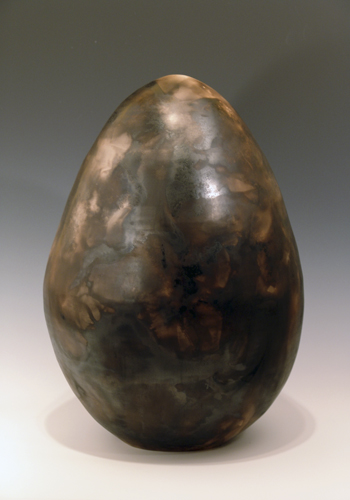
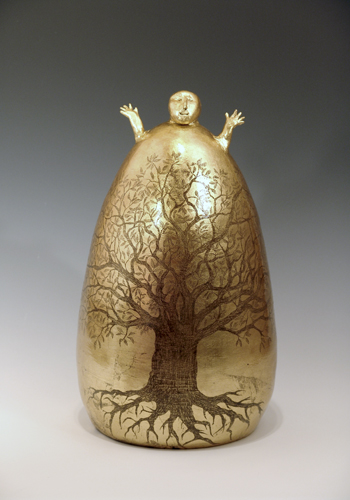

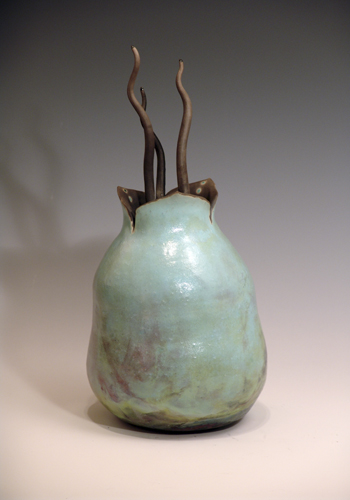
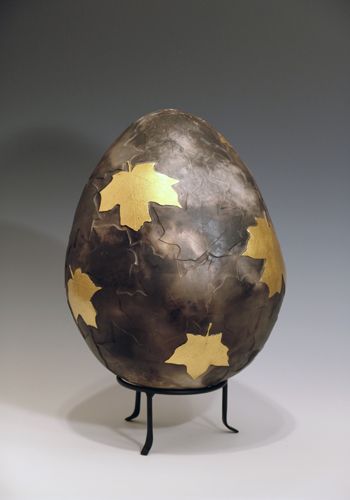
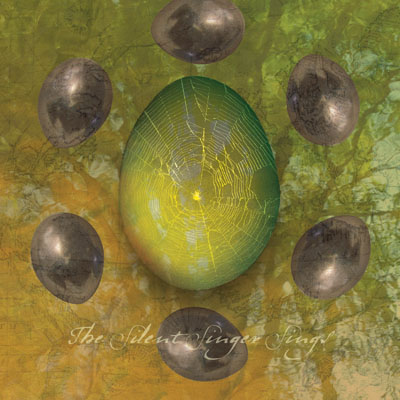
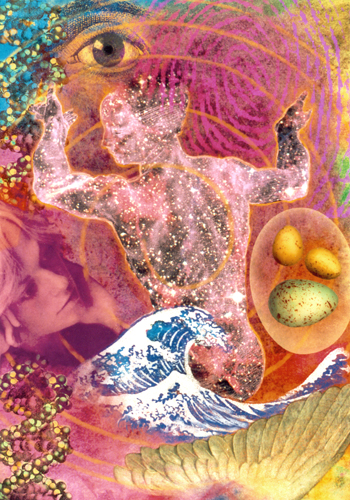
There is nothing mysterious about the shape of an egg. Round or oval, smooth, it is perhaps the most familiar of our world of shapes. Rather, the mystery of the egg lies inside the thin, protective shell – in its potential. The structure itself is delicate, yet resilient. We know it to be one of the strongest designs in nature: when end on end, it is formidable. Yet it is the most fragile of objects, easily broken when dropped. Live eggs must be incubated for their inhabitants to survive. This presents a paradox – this strength and vulnerability.
Laura Drabant and Pamela Belding in their collaborative exhibition “Vital Force: The Alchemy and Potential of the Egg and Seed,” chose to emphasize the egg as seed, as potential. As a metaphor for art making, they use the egg form as a substrate upon which to play out their ideas. It’s an interesting collaboration: Belding is a 2-dimensional colorist and Drabant’s ceramic work leans towards simplicity of form and color. Both women have a tendency to use essential forms in their individual work, so choosing the egg and seed as common ground allowed them to combine their individual traits. What results is precious strength – a body of work that is perhaps more simple and decorative than either would have created on their own.
For their collaborative pieces, Belding and Drabant stuck pretty closely to the egg form. Drabant created the eggs, from approximately 4” tall to two feet (appropriately titled “XL Jumbo”) in scale, then she let go and allowed Belding to carve into the half-fired clay or to use another technique called “sgrafitto” which is to scratch into the surface to reveal something underneath, in this case, to scratch into gold or silver leaf. The effect on the smaller eggs in particular is gorgeous. The scratching has the effect of being delicate and rough at the same time, in the sense that one can feel the artist’s hand when holding it. They are incredibly seductive – right away I wanted one – but whether this was because of the “shiny object syndrome” (as Drabant jokes about in her press release), or the familiar, comforting shape of the eggs I am not sure. At this size, even the unadorned eggs – although the smoky finish of the firing is sexy in its own right – call out to be taken home, talked to every day, incubated. In this case, I believe it is the “pet rock syndrome” I am victim of.
Not so the larger pieces. The big eggs feel almost threatening. If I think of these shapes and the knowledge of their potential, it makes me wonder what on earth is in there. They are heavy, seem to be weighted down by their own impossibility; like an oversized dome, how could this object not cave in upon itself? It is the extra large, unadorned eggs that are most aggressive – their deep smoke surfaces are fascinating to look at, but the lack of mediation makes them ponderous. In contrast, the large eggs covered in gold leaf almost seem to float. On two of them, Belding has scratched a single tree. They are beautiful images – her technique is detailed and fine. One of these eggs is mediated by a man-form popping out of its top.
This “Golden Tree Man” became the most important piece of the collaboration for Belding. To some degree it sums up the combination of their efforts, as she describes him as being “exclamatory and contemplative at the same time.” In looking at their work, I noticed that Drabant exhibits a playfulness and Belding a greater sense of asceticism. The golden man popping out of the austere golden egg takes on a sense of life (and comedy) that many of the other collaborative pieces do not achieve, unlike Drabant’s solo work, which seems to often go for the surprise or giggle (see her website for oversized coffee beans, playing against the smoky fire of her finish).
The gold-leafed tree pieces reveal the inherent limitations of the egg form. Some of Drabant’s solo works, in contrast, have surprises inside. The lips of seeds are pulled aside, and there’s an element of sound—they rattle (as do some of these eggs). But in this show it’s the two carved eggs that seem to challenge the compositional simplicity of the egg form. In these two floral eggs (one standing, the other lying down), the viewer is unable to tell where the carving begins and ends; as the scrolling gets lost in the tonal variation of the smoke glaze, it becomes a welcome visual challenge for the viewer.
This was Belding’s first time working with ceramics. There were times when Drabant “gasped when I saw how deeply she had carved the flowers into a medium smoked fired egg – I didn’t think it would ever make it through the kiln.” The two women had to learn from each other – testing themselves and their abilities. For Belding, learning a deep appreciation for the process of ceramics and to then let go of the piece – to give it over to the fire. For Drabant, it was giving it over to Belding! The two women worked side by side through the process, they shared a space and kept open communication as to where each piece should go. Drabant’s “Eureka” moment was when the first small egg was covered in gold leaf; but it was the “Maple Leaf Egg” that defined the collaboration for her. She says, “It was one of the last pieces we did. I think the size and shape are just right…. the fact that there are gold leaves on it reminds me that this egg, this symbol of potential, was created at the beginning of Autumn. It’s a nice reference to the life/death cycle.”
Of Belding’s solo work inspired by the collaboration, she has shown several digital prints, letting us see her bold color sense that has been sacrificed in the collaborative pieces. In her smaller digital collages, she uses similar elemental symbols (egg, moon, sun, stones), clearly attempting to tie this work to the ceramic pieces. With a deft hand, she blends the forms she uses, although there persists a symmetry and simplicity to the compositions that differs from her solo work. She says that color for her is addictive, and that is evident in her solo projects, which feature bold shapes of rich color. To submit herself to the virtual absence of color was a good challenge and I am sure will inform her future work. It reminds me of the subject of Oliver Sack’s article “The Case of the Colorblind Painter,” who loses his ability to see color and must learn to see the world and all its variety all over again, but in neutralized tones. To spend time meditating on the tonal variations and shades of the smoke glaze, imagining the fire that formed it, is bound to touch one’s color sensibility.
For the two women, the collaboration presented an opportunity to learn from another’s process and to hone communication skills. Indeed, the concept of egg or seed is a very simple metaphor for the creative process. In its whole form, the egg has a sense of timelessness, yet it is pregnant with expectation. The eggs, therefore, cannot be entirely still. In my mind, they are restless for change and I am eager to see what might come next.
However, with the unity of shape presented here, I wonder about the influence of the egg, which seems to have overwhelmed the seed, at least with the collaborative work. We tend to think of the shape as classic bird eggs – a tapered oval, monochrome, smooth (although biological investigation will tell us that they come in many shapes, and in fact human ovum, like that of fish, is circular), but seeds are ever varying, with twists and turns and most importantly, carriers. Think of whirly-gigs and acorns, vanilla pods and cocoanuts… Perhaps the potential for this body of work, if Drabant and Belding continue this fruitful collaboration, will be moving on to different forms, searching for variety in the elemental.